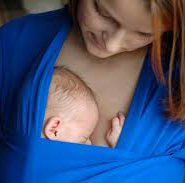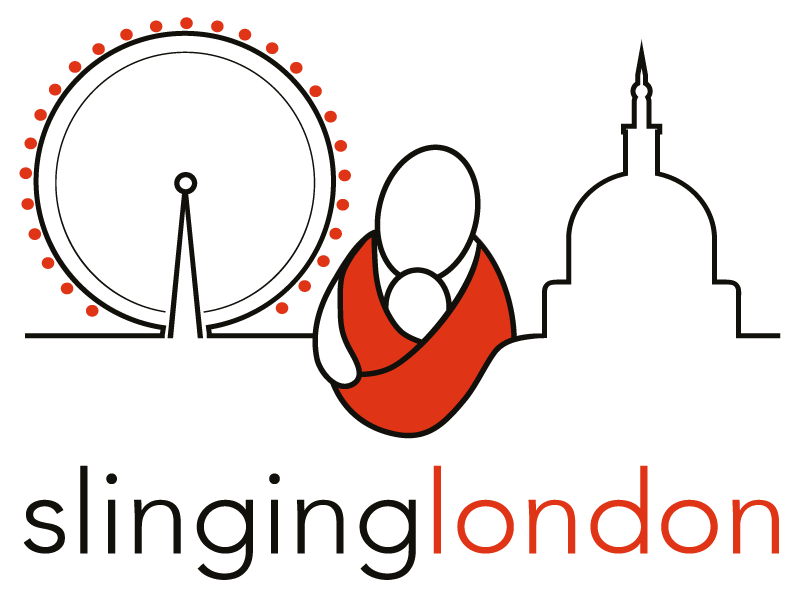We want to make soft baby carriers available in postnatal, neonatal intensive care and special baby care units throughout London and eventually the UK. The use of soft baby carriers in the precious few days after birth will be invaluable to both mothers and healthcare providers in the following areas:
skin to skin & kangaroo care
Kangaroo care is a method of holding a baby that involves skin-to-skin contact. The baby, who is  naked except for a nappy and a piece of cloth covering his or her back (either a receiving blanket, the parent’s clothing or ideally a stretchy wrap), is placed in an upright position against a parent’s bare chest. The longer the child is held against the parents skin the quicker and better the outcome.
naked except for a nappy and a piece of cloth covering his or her back (either a receiving blanket, the parent’s clothing or ideally a stretchy wrap), is placed in an upright position against a parent’s bare chest. The longer the child is held against the parents skin the quicker and better the outcome.
The use of a stretchy wrap under a blanket or parents clothing means that the parent isn’t stuck to a seated position. They can wander around the ward, use the facilities and be more independent and less reliant on hospital staff. The more active the mother is after the birth the quicker the healing begins.
What are the benefits of kangaroo care?
- Mimics the soothing environment of the womb – The baby has just been in a safe, enclosed, and warm environment. Wrapping a baby skin to skin mimics the familiar environment of the womb as the baby continues to receive touch, rhythm and pressure. Not only does the baby have a feeling of containment, (as opposed to lying on a flat bed in an incubator) but also the soothing and comforting sounds of his mother’s heart beat and breathing and rhythmic rocking that he was so accustomed to.
- Regulates body temperature – A mother has actual “thermal synchrony” with her infant. When a baby is placed in the kangaroo position, skin to skin with his mother, the temperature of the mother’s breasts actually change so that her baby can better maintain his own temperature. If the baby gets too cold the mother’s body temperature will actually warm up one degree to help warm the baby. If the baby gets too hot, the mother’s body temperature will decrease one degree to cool the baby. This even works when twins are kangarooed (Ludington-Hoe, 2004). Furthermore, the flexed position that the baby assumes on his mother’s chest as opposed to lying on his back in an incubator is a more efficient position for conserving heat.
- Enhances lactation, the prevalence and duration of breastfeeding – With easy access to the breast, mothers experience easier let down, increased milk supply (Furman,2002). Mothers are more likely to breastfeed exclusively and have more success with prolonged nursing (Figueroa de Leon).
- Enhances immunological protection – If the mother is breastfeeding her baby, she will raise antibodies in response to all of the microbes that they come in contact with and transfer them to the baby (Lawn, 2010). Some antibodies can even be transferred skin to skin (Telemo,1996). Touch is so important to the healthy development of an infant that a lack of touch, or separation of mother and newborn, actually causes high amounts of the toxic stress hormone cortisol to be released. High levels of cortisol in the blood and separation from mother may negatively impact immune function as the body may stop producing leukocytes.
- Lessens crying – Babies, both preterm and full-term, cry less when placed in skin to skin contact with their mothers. Decreased crying means less stress and subsequently lower levels of cortisol.
- Enhances growth/weight gain – High cortisol levels that result from mother baby separation have a negative impact on growth hormone. With mother present to help assist in regulating the baby’s breathing, heart rate, and temperature, the baby has decreased energy needs and can conserve his energy and calories, and direct it toward growth. (Charpak, 1997). In an upright prone position babies also regurgitate less (Ludington-Hoe, 1993).
- Leads to shorter hospital stays – Babies that are practicing Kangaroo Care can have up to a 50% shorter hospital stay than babies who are not “kangarooed” (Charpak,1997).
- Provides a buffer against over-stimulation – In an upright prone position babies tolerate noise and activity around them much better (Ludington Hoe, 1993). A typical NICU is a very busy place.
- Supports arousal regulation – When held skin to skin with their mothers, babies spend more time in a quiet alert state. When carried in mother’s arms, the baby is in a safe place from which to view the world. It is from this safe known place that babies learn about the unknown. In a calm and alert state and in touch with mother, a baby is in the optimum state for observing and processing.
- Reduces apnea and uneven breathing – Kangaroo Care markedly decreases apnea episodes in preterm infants (Ludington,1998). When a baby is placed skin to skin on the chest of either parent there is usually an improvement in breathing patterns. The baby can hear the breathing and it stimulates the baby’s breathing so that the baby imitates the parent (Ludington, 1998).
- Stabilizes heart rate – Heart rate is actually more regular in babies under Kangaroo Mother Care (McCain, 2005). During KMC, bradycardia (low heart rate below 100) is markedly reduced and tachycardia (heart rates of 180 or more) rarely occurs (Ludington-Hoe,1993). Babies’ cardio status stabilized faster after open heart surgery with Kangaroo Care (Gazollo, 2000). Heart rate is so important because baby’s brain requires a steady and consistent flow of blood to get the oxygen it needs to grow and perform properly.
- Relieves stress reactions – Babies deal with pain better and cry less in response to pain (for procedures such as heel sticks) while Kangarooed (Kostandy, 2008).
- Improves neurobehavior – Preterm babies that were given many hours of KMC in the early weeks after birth, compared to those given little or no care, scored higher on mental and motor development tests in the first year of life (Charpak et al., 2005).
- Increases oxygenation of the baby’s body (Feldman, 2003).
- Assists in bonding process and builds attachment – increases maternal sensitivity, responsiveness and connectedness (Dodd, 2005).
- Builds parent confidence and competence – Holding baby close reduces stress among parents and family (Feldman et al., 2002, 2003). Kangaroo Mother Care empowers parents as they feel that they can do something incredibly beneficial and positive for their preterm infants.
- Helps parents play an active rather than passive role in their baby’s recovery.
- Provides longer periods of restful sleep – Kangaroo Care when carried out in a low light, quiet environment with any baby, full or preterm, helps babies to remain more calm and transition from one sleep state to another (Ferber, 2004). Preterm babies were found to have spent more time sleeping during Kangaroo Care (Messemer, 1997).
- Saves lives – The latest studies show a 51 percent reduction in newborn mortality when babies (stable and less than 2 kg) were kangarooed within the first week after birth and breastfed by their mothers.(Lawn,2010)
- It is safe. Not one study has proven that it can hurt your baby.
Many thanks to www.bobafamily.com for the use of this information.
